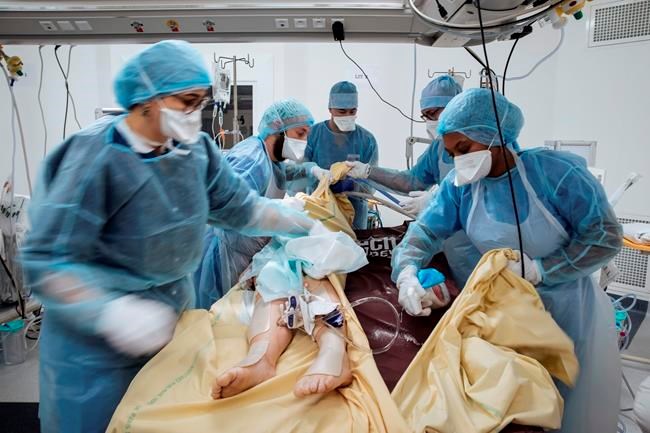PARIS — Cradling the head of the deeply sedated COVID-19 patient like a precious jewel in his hands, Dr. Alexy Tran Dinh steered his intensive-care nurses through the delicate process of rolling the woman off her stomach and onto her back, guiding the team like a dance instructor.
They moved only on Tran Dinh’s count, in unison and with extreme care, because the unconscious patient could die within minutes should they inadvertently rip the breathing tube from her mouth.
“One, two and three — onto the side," the doctor instructed.
His next order quickly followed: “Onto the back."
“Perfect,” he concluded when the move was done.
Pulling in three nurses and a burly care worker from another section of the Paris hospital, the series of
And she was just one of nearly 6,000 critically ill patients still in French intensive care units this week as the country embarked on the perilous process of gingerly easing out of its latest lockdown — too prematurely for some frontline workers in hospitals.
French President Emmanuel Macron's decision to reopen elementary schools on Monday and allow people to move about more freely again in May — even though ICU numbers have remained stubbornly higher than at any point since the pandemic's catastrophic first surge — marks a shift away from prioritizing hospitals that is taking place in multiple European capitals.
In France, Greece and elsewhere, the cursor is moving toward other economic, social and educational imperatives. Governments are using ramped-up vaccinations to bolster arguments to ease restrictions, although just one-quarter of adults in Europe have received a first dose.
With record-high numbers of COVID-19 patients in critical care, Greece announced the reopening of its tourism industry from mid-May. Spain's prime minister says the state of emergency that allowed for curfews and travel bans won't be extended when it expires May 9, in part because vaccinations are allowing for a safe de-escalation of restrictions. This despite more than 2,200 critically ill COVID-19 patients still occupying one-fifth of Spain's ICU beds.
Beginning Monday, in low-risk zones, Italy’s schools can reopen for full-time, in-person learning, and restaurants and bars can offer sit-down, outdoor service. The Netherlands is ending a night curfew and reopening the outdoor terraces of bars and cafes for the first time since mid-October, even as hospitals scale back non-urgent care to increase ICU beds for COVID-19 patients.
In France, Prime Minister Jean Castex said the latest infection surge that pushed the country's COVID-19-related death toll beyond 100,000 people has begun a slow retreat, allowing for all schools to reopen and day-time travel restrictions to end starting May 3. Castex also raised the prospect that stores and outdoor service at restaurants and cafes closed since October could reopen in mid-May.
“The peak of the third wave appears to be behind us, and the epidemic’s pressure is lifting,” Castex said Thursday.
That's not how it feels to Nadia Boudra, a critical care nurse at Bichat Hospital in Paris. Her 12-hour shift Thursday started with the unpleasant job of sealing the corpse of a 69-year-old man who died overnight with COVID-19 in a body bag, just hours before his daughter flew in from Canada hoping to see him alive.
“We have our noses in it. We see what’s happening, we see that people are dying — a lot," she said. For her, reopened schools and, possibly, outdoor eating and drinking in May are “too soon" — a misleading message that “things are getting better.”
“Clearly," she said, "that is not the case.”
After sending the man's body to the hospital morgue, Boudra tended to the critically sick retired waitress, now the solitary occupant of the makeshift ICU set up for COVID-19 patients in what had been an operating room. The tender care, expertise and technology poured into keeping this one woman alive offered a micro-level look at the momentous national efforts — human, medical, financial — that France and other countries are still expending in ICUs as healthy people now plan May getaways and drinks with friends.
As the woman lay unconscious, 5,980 other gravely ill patients were also being kept alive with round-the-clock human and mechanical devotion in other critical care units across France. Automated drips supplied sedatives, painkillers and drugs to prevent deadly blood clots and leaks from the woman's veins. Enriched oxygen, first bubbled through water to warm and humidify it, pumped mechanically into her lungs. The ICU team also took a call from the woman's daughter, who telephones morning and night for news. It was bad on Thursday morning: Tran Dinh told the daughter her mother's breathing had deteriorated.
“If you took away the machines, she would die in a few minutes, perhaps less,” the doctor said. “There is no room for error.”
Yet this patient wasn't even the most fragile. An artificial lung, a last resort for patients with lungs ravaged by the disease, was keeping a 53-year-old man alive. Costly and resource-intensive, the state-of-the-art treatment is reserved for patients thought strong enough to have a chance of surviving. About 50% still die, said Dr. Philippe Montravers, who heads the surgical ICU department at Bichat, run by Paris' hospital authority, AP-HP.
His unit has four of the ECMO machines — all of them used for COVID-19 patients. The man has been hooked up to his for over a month but "is not improving at all,” Montravers said.
“This machine only buys time,” he said. “It’s a life buoy, nothing more.”
Nurse Lea Jourdan said tending to someone so fragile is physically and mentally wearing.
“You have to be careful about everything, all the tubes, not ripping anything out when you turn him over,” she said. ”It's tough to see the positive and say to oneself, ‘He will survive.’"
___
AP writers Mike Corder in The Hague, Netherlands, Nicole Winfield in Rome, Aritz Parra in Madrid and Elena Becatoros in Athens, Greece, contributed.
___
Follow AP’s pandemic coverage at https://apnews.com/hub/coronavirus-pandemic, https://apnews.com/hub/coronavirus-vaccine and https://apnews.com/UnderstandingtheOutbreak
John Leicester, The Associated Press

